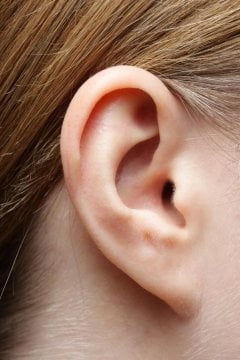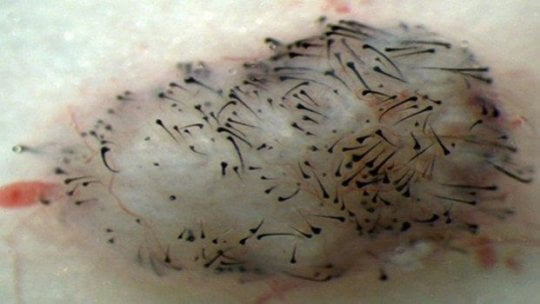BALTIMORE — Scientists and engineers are 3D printing all types of objects these days, including eyes: A group of eye specialists and eye-care providers from the Netherlands has used 3D-printing technology to create artificial eye structures, called conformers, in a small study of five children.
The technique could help children with conditions called microphthalmia and anophthalmia, in which they are born with underdeveloped or missing eyes, respectively, the research team says. These conditions, which can occur in one or both eyes, affect more than 10 percent of blind children worldwide and as many as 30 in 100,000 children, according to previous studies.
Although the sculpted eyes don’t enable the child to see, they do provide critical support of the eye socket so that the child’s face can have a natural, proportional look, the researchers said today (May 11) here at the annual meeting of the Association for Research in Vision and Ophthalmology (ARVO), the world’s largest gathering of eye and vision researchers.
“If there’s no eye present, there’s not enough adequate stimulus for the bone [around the eye socket] to grow,” Maayke Kuijten, a postdoctoral fellow at the VU University Medical Center in Amsterdam who conducted a study on five children fitted with the conformers, said at ARVO. [The 10 Weirdest Things Created by 3D Printing]
Because children with these conditions may have malformed eye sockets, the face and the areas around the eyes cannot expand to their natural contour, Kuijten said. The advantage of 3D-printed eye conformers is that they can be replaced often with slightly larger sizes by the parent at home as the child grows, or as frequently as weekly when the child is a few months old, she said.
“Symmetry of the face is our end goal,” Kuijten told Live Science.
Traditionally, a child or adult who is missing an eye would be fitted with a device called an ocular prosthesis. (This was commonly called a “glass eye” because it was originally made with glass, but it is now mostly made of a medical-grade plastic acrylic.) These ocular prostheses are made by ocularists, professionals who are trained in both the fabrication and fitting of the prostheses.
The ocular prosthesis can be nearly spherical, like the eyeball, or cup-like, to fit over an existing, malformed and nonfunctioning eye. A conformer is often used for temporary support, such as after the accidental loss of an eye, to maintain the eye socket for several months until a more permanent prosthesis can be fitted.
But making and fitting an ocular prosthesis, or even a conformer, is a laborious process, Kuijten said. The ocularist typically must visually gauge the size of the socket, create an orb based on educated guesswork and polish it until it fits perfectly. It is as much artwork as it is medical care.
For infants with microphthalmia or anophthalmia, time is critical because their rapidly growing heads need the stimulation of a full-size eyeball for the frame of the eye socket to expand accordingly. Without such stimulation, that section of the skull can cave inward.
3D-printed conformers help address this challenge because they can be printed quickly, cheaply and in a range of sizes varying by less than a millimeter in diameter, Kuijten said.
To test the utility of 3D-printed conformers, Kuijten’s team looked at patients being treated by Dr. Dyonne Hartong, an oculoplastic surgeon at the VU University Medical Center who is currently treating about 50 patients with microphthalmia or anophthalmia. Hartong was the senior investigator on the study.
As part of the standard care of children with these eye conditions in the Netherlands, they have several ultrasounds of their head taken during their first 3 months of age, followed by an MRI scan when they’re about 3 months old. (MRIs require anesthesia because babies cannot be instructed not to move during the scans. But administering anesthesia to newborns under 3 months is considered too dangerous.)
Using data from these scans, the researchers determined the extent of the eye malformation and the size of the eye socket. The doctors also injected a soft gel into the affected eye socket to create a crude mold of its shape.
Based on these measurements and data on natural growth development, Kuijten devised an eye-growth chart for these children for their next 10 years of development. Then, her group used a 3D printer to create customized conformers in a vast array of sizes matching the prediction of the growth charts. [7 Cool Uses of 3D Printing in Medicine]
The conformers don’t look like eyes. In fact, the original batch of eyes were green, with no pupils colored in. But they are convenient enough for parents to fit into their baby’s eye socket after they’re trained by ocularists on how to do so. Kuijten said the treatment is noninvasive and not painful for the child.
Early evaluation has shown that socket volumes of the treated eyes doubled, on average, over the treatment time of about a year, thus indicating that significant socket expansion occurred, the researchers said. The study on these children is ongoing.
“This is certainly a novel approach with several advantages,” said Dr. Irene Gottlob, a professor of ophthalmology at the University of Leicester Ulverscroft Eye Unit at the Leicester Royal Infirmary who was not involved in the study. “This is a good example of individualized treatment, or ‘precision medicine.’ It is also a good example of how 3D printing can be used in medicine.”
“However, so far, only five patients have been treated, and we need to see the results of a larger group,” Gottlob added.
Gottlob said she was encouraged by the researchers’ plan to improve mathematical models to better predict eye-socket growth and development. She also noted that better refinement of ultrasound scans could help bring the method to younger infants, before they reach the age when they can safely undergo an MRI scan.
“I think this is a very promising … method, but experience with more patients and further development will improve this even further,” Gottlob told Live Science.
Follow Christopher Wanjek @wanjek for daily tweets on health and science with a humorous edge. Wanjek is the author of “Food at Work” and “Bad Medicine.” His column, Bad Medicine, appears regularly on Live Science.
[“Source-Gadgets”]




















